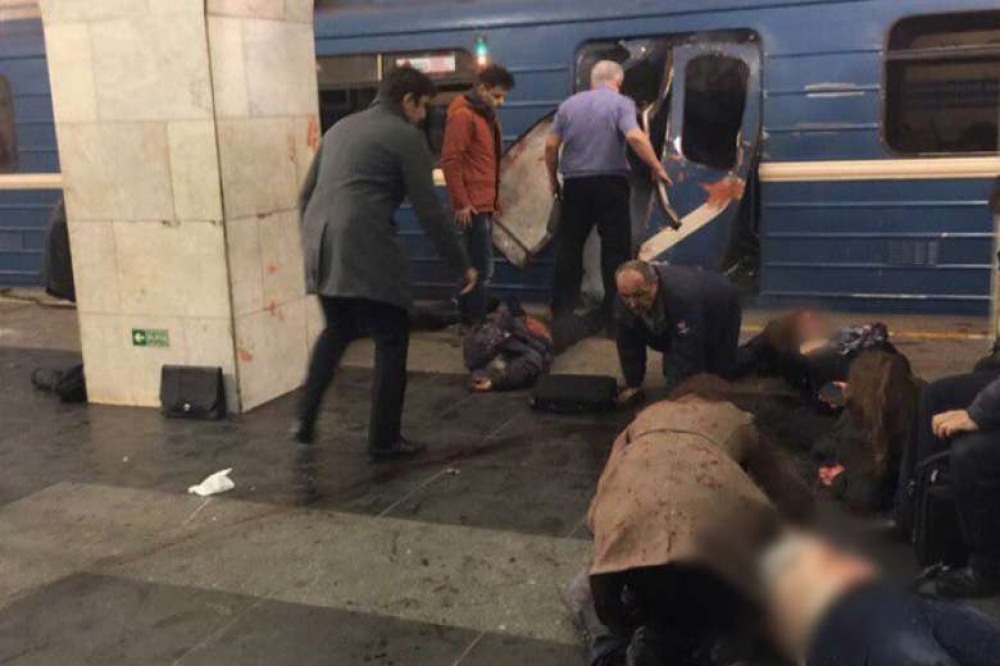Two suspects hunted following St Petersburg metro explosion
Ten people were killed and dozens more injured in a bomb blast in the St Petersburg metro system

Russian authorities are hunting for two people suspected of organising and carrying out a bomb blast on a St Petersburg metro train, which killed 10 people and wounded dozens more, and leaving a second explosive device at a metro station.
The explosion occurred at around 2.30pm local time on Mona, after the train had left Sennaya Ploshchad station in the centre of St Petersburg. The driver made the decision to continue to the next station, Tekhnologicheskii Institut, in order to make evacuation easier.
The explosive device had been left inside the carriage, according to law enforcement sources. Those on the train spoke of a blast that was mainly felt in the carriage where it occurred, three from the front of the train.
“I don’t think it was that loud, but then I was wearing headphones,” said Andrei Shurshev, who was in the next carriage along. He told the Russian news site Meduza that after the blast, there were some sparks and dust in his carriage, and a smell of smoke.
“We went to the end of the carriage and got out at the station. In the next carriage there were no lights, and a lot of smoke. People were smashing the windows to get out. I saw a metro employee pulling out an injured person.”

Shurshev said the metro at that point was still working, so he got on a train on another line and continued his journey. Trains even continued pulling into the affected platform in the other direction, after the blast.
“We went past Tekhnologicheskii Institut, and I could see people lying on the platform and smoke” a passenger named Oleg told the news site Bumaga. “When the train stopped, people got out, but then the doors quickly closed and the train carried on to the next station,.”
In the hours after the blast, Russia’s anti-terror agency said a second bomb had been found and defused at Ploshchad Vosstaniya, anothermetro station in the centre of the city. Interfax said the second bomb would have been several times more powerful than the first, and was reportedly a device disguised as a fire extinguisher that had been rigged with shrapnel.
Ten people were confirmed killed, and St Petersburg authorities said 43 were being treated in hospital.

“Everything was covered in smoke; there were a lot of firefighters,” Maria Smirnova, who was travelling in the next train behind the one where the bomb detonated, said. “Firefighters shouted at us to run for the exit and everyone ran. Everyone was panicking.”
The blast occurred while the Russian president, Vladimir Putin, was in St Petersburg – his home town. In the morning he spoke at a forum, while in the afternoon he had a meeting with the Belarus president, Alexander Lukashenko. Opening the meeting about an hour after the blast, Putin expressed his condolences to families of the victims.
He said it was “too early to say” what caused the blast but that it could be “criminal or terrorist”. Putin said he had already spoken with the director of the FSB security services and other law enforcement agencies.
Shortly after, Russia’s investigative committee said it was working on the basis that the blast was a terrorist act, although other possibilities were also being explored. Authorities were searching for two people, one who left the bomb on the train which exploded, and one who left the unexploded bomb at Ploshchad Vosstaniya.
Solidarity with the people of #StPetersburg -JM
— Joseph Muscat (@JosephMuscat_JM) April 3, 2017
Putin emerged from talks with Lukashenko more than five hours after they began, and in a joint press appearance, spoke about negotiations on gas prices and other bilateral Russia-Belarus issues, but said nothing more about the explosion. Lukashenko thanked Putin for having fruitful discussions on a “difficult day” and expressed his own condolences over the attack.
As of Monday evening, there had been no claims of responsibility for the attack, and the internet was awash with various conspiracy theories. Most analysts suggested the most likely culprits would be Islamist insurgents, possibly linked to Islamic State.
For many years, Russia suffered frequent terror attacks from Islamist groups based in the North Caucasus, including blasts on the Moscow metro in 2010. However, since a suicide bomber struck at Domodedovo airport in January 2011, attacks have largely been confined to the North Caucasus itself.
Since Russia entered the war in Syria in September 2015, a number of Islamic State propaganda outlets have said the country would be a target. In October 2015, a plane travelling from Sharm el-Sheikh in Egypt to St Petersburg crashed, apparently after an explosive device was detonated on board. Isis claimed responsibility.
St Petersburg’s subway system carries 2 million passengers a day and is busy most of the time. The whole system was closed in the aftermath of the blast, and a number of streets at ground level were also shut off, as medical helicopters landed at the scene to evacuate the injured. By evening, several metro lines had reopened.




.png)














.png)

